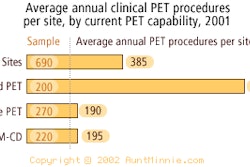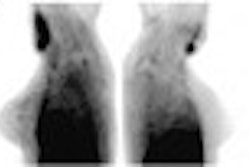Once an also-ran to other technologies, PET is finally coming into its own within the diagnostic armamentarium of the nuclear medicine physician. One sign of PET’s arrival was the fact that PET and SPECT results tied for Image of the Year at the 2002 Society of Nuclear Medicine meeting, June 18-21, in Los Angeles.
Researchers from the Johann Wolfgang-Goethe Clinic, University of Frankfurt, Germany, conducted the winning PET study and sought to evaluate the use of F-18 FDG-PET for screening malignancies in patients with paraneoplastic syndromes.
The victorious SPECT scans came from the University of Pennsylvania in Philadelphia. There, researchers used the modality to perform quantitative studies of dopamine transporters in the functional imaging of small animals using ultra-high-resolution SPECT.
While PET has been at the forefront of nuclear medicine for some time, both modalities were given their fair share of coverage at the 49th conference. Another popular topic was the combination of radionuclide imaging with sentinel node biopsy for the improved treatment of breast cancer. The following are highlights from select 2002 SNM studies.
SPECT
Researchers from Japan and Brazil assessed the value of dobutamine SPECT for determining myocardial viability. Dr. Keiichiro Yoshinaga and colleagues from Hokkaido University Graduate School of Medicine in Sapporo looked at whether low-dose dobutamine stress-gated (DS) SPECT may provide additional value to stress-rest technetium-99m (99mTc) tetrofosmin SPECT for the detection of myocardial viability.
Dr. Marcus Simoes and colleagues from the Medical School of Ribeirao Preto, University of São Paulo researched the possibility of using low-dose dobutamine-gated (LDD) SPECT with thallium-201 for assessing early contractile reserve after acute myocardial infarction (AMI).
"The addition of low-dose dobutamine functional information to a dual-isotope protocol can augment the accuracy of SPECT assessment," according to Dr. Sherif Heiba from St. Vincent’s Catholic Medical Centers and New York Medical College in New York City.
At the Children’s Hospital at Westmead in Sydney, Australia, a new software program co-registers nuclear medicine with CT or MR images, resulting in changes to pediatric cancer management and assessing for recurrence.
PET
Investigators from Berlin compared late contrast enhancement MRI (LE-MRI) with PET for gauging myocardial viability. The study included 10 patients with stable coronary artery disease and significantly reduced left ventricular function. Each patient was scanned once with FDG-PET, and twice with MRI over a 5-12 month interval, following the administration of gadolinium (III) diethyltriaminepentaacetic (Gd-DTPA).
A group from State University of New York at Buffalo successfully used PET scans to show signs of progressive coronary artery disease in one in four cardiovascular patients despite therapy with lipid-lowering agents. The findings suggest that physicians should consider the routine use of PET scans to determine which patients are at risk for cardiac events, even when medical treatment appears to be successful.
PET can also can help physicians predict whether preoperative chemotherapy will be successful in patients with gastric cancer, according to a study out of the Technical University of Munich in Germany. Their work showed that in patients with gastric cancer, response to preoperative chemotherapy can be predicted by FDG-PET early during the course of therapy.
FDG-PET turned in good results for studying chronic osteomyelitis. According to researchers from Ghent University Hospitals in Ghent and Aalst, Belgium, FDG-PET proved to be more accurate than Infecton SPECT.
Researchers from Lawrence Berkeley National Laboratory in Berkeley, CA, reported on an algorithm that reduced patient motion artifacts, and produced more finely tuned PET images. The formula corrects normalization during image rebinning, thus picking up on missed data.
Dr. Marc Hickeson and fellow researchers from the Hospital of the University of Pennsylvania in Philadelphia outlined a protocol to improve the accuracy of pulmonary nodule FDG-PET imaging. The technique involved imaging patients at two time points, versus traditional single-time-point PET.
Finally, Dr. Harry Agress Jr., offered advice on marketing a PET facility to referring physicians. Being patient and working with physicians on a one-on-one basis will go a long way toward mitigating resistance to PET imaging, he recommended.
Biopsy
Researchers from St. Vincent’s Hospital and Medical Center in New York City and the Hospital of the University of Pennsylvania in Philadelphia reported new applications for sentinel node (SN) localization in breast cancer patients.
Dr. Suman Jana and colleagues at St. Vincent’s investigated where multifocal/multicentric breast carcinoma was an absolute contraindication for sentinel node localization. A combination of radiocolloid and blue dye SN came in with a sensitivity, negative predictive value, and accuracy of 100%.
Dr. Robert Canter and colleagues from the Hospital of the University of Pennsylvania
analyzed locoregional and distant recurrence rates among patients with metastatic disease presented in the sentinel lymph node (SLN).
"Patients with lymph node involvement beyond the SLN have a significantly higher risk of early distant recurrence than patients who are SLN-positive only," Canter said. "In patients with a positive SLN, completion of axillary dissection identifies patients with a higher risk for systemic failure in whom more aggressive therapies may be warranted."
Sentinel lymph node biopsy offers a reliable, less invasive alternative to axillary lymph node dissection for many breast cancer patients with small tumors, particularly when it is performed by experienced physicians, reported a group from the University of Ulm in Germany.
Dr. Chantal Curtet, representing a team from the Cancer Center North Hospital in Nantes, France, presented compelling evidence that surgeons should search for and remove not only one sentinel lymph node but also sometimes two or more sentinel nodes using preoperative radiodetection.
The 2003 SNM conference will take place in New Orleans from June 21-25.
By Shalmali Pal
AuntMinnie.com staff writer
September 6, 2002
Related Reading
Late-enhancement MRI compares to FDG-PET for gauging myocardial viability, August 26, 2002
Dobutamine SPECT helps assess myocardial viability, August 19, 2002
SN localization proves worthwhile in multifocal invasive breast carcinoma, August 12, 2002
Successful PET centers require planning and persistence, July 15, 2002
Dual-time-point FDG-PET improves pulmonary nodule assessment, June 21, 2002
New algorithm puts twists on PET imaging rebinning, June 20, 2002
Infecton SPECT, FDG-PET illuminate skeletal infections, June 19, 2002
Sentinel lymph node biopsy backed for breast cancer, June 19, 2002
Low-dose dobutamine enhances SPECT detection of myocardial viability, June 19, 2002
PET scans may help predict chemotherapy response, June 18, 2002
SPECT coregistration improves treatment at pediatric care center, June 18, 2002
PET identifies heart patients at risk despite lipid therapy, June 18, 2002
Copyright © 2002 AuntMinnie.com




















